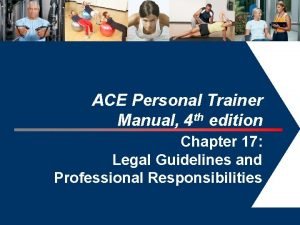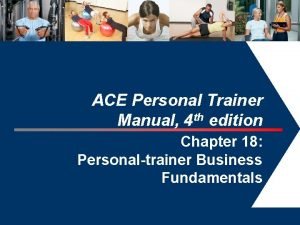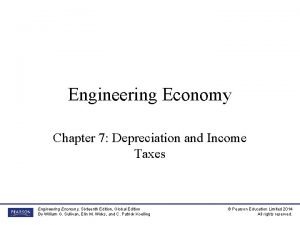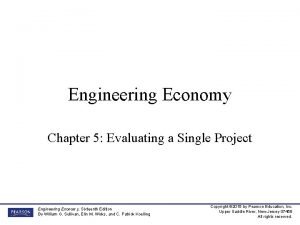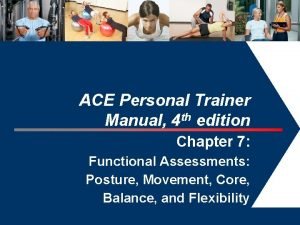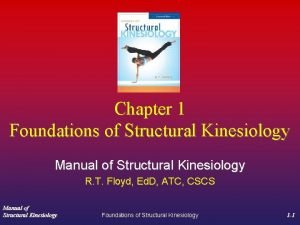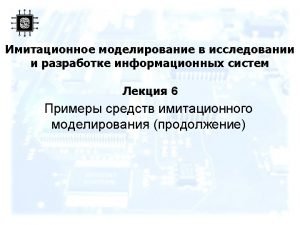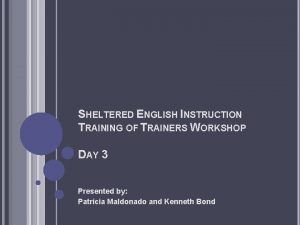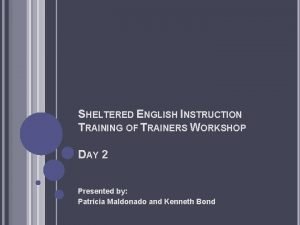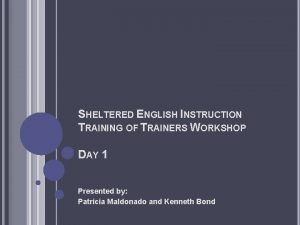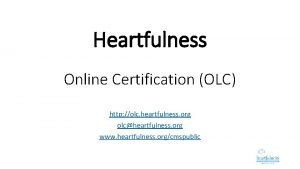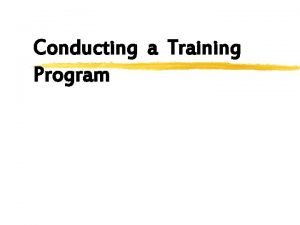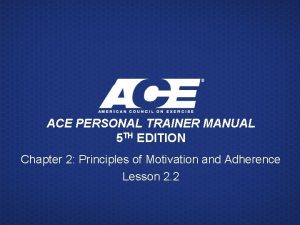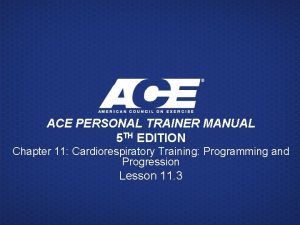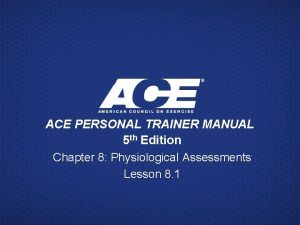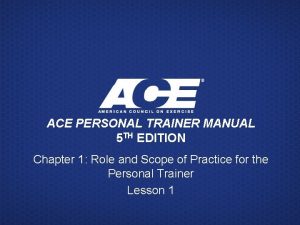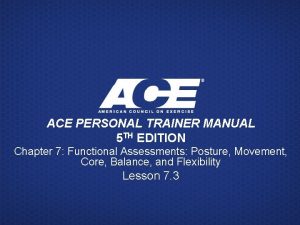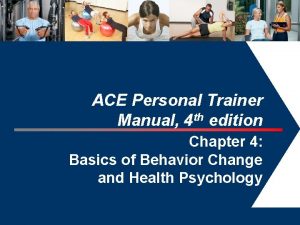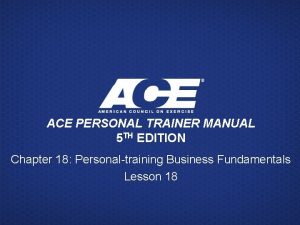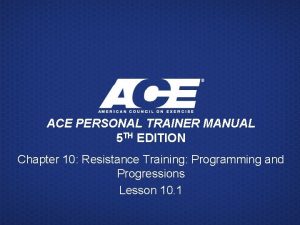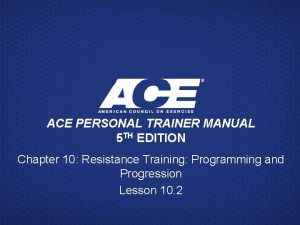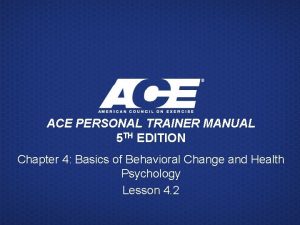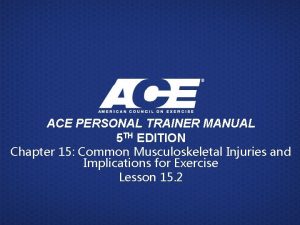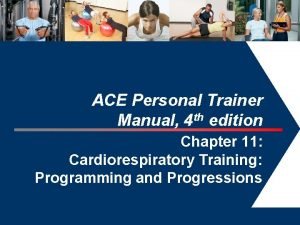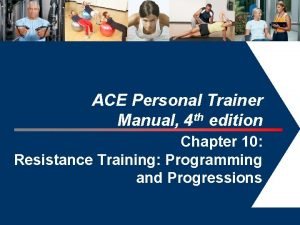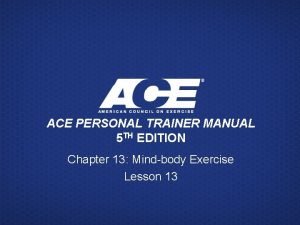ACE Personal Trainer Manual 4 th edition Chapter






















- Slides: 22

ACE Personal Trainer Manual, 4 th edition Chapter 5: Introduction to the ACE Integrated Fitness Training. TM Model 1

Learning Objectives § This session, which is based on Chapter 5 of the ACE Personal Trainer Manual, 4 th ed. , introduces the ACE Integrated Fitness Training (ACE IFTTM) Model. § After completing this session, you will have a better understanding of: – The health—fitness—performance continuum – How rapport and behavioral strategies fit within the ACE IFT Model – The training components and phases of the model and how they can be utilized to provide individualized training solutions for any client

Introduction § Personal training has evolved to meet the challenges of an aging and increasingly overweight population. § Personal trainers are also seeing an influx of special needs clients. § Due to these expanded client needs, new training parameters outweigh the traditional training parameters. § The ACE IFT Model provides personal trainers with a systematic and comprehensive approach to exercise programming.

The Health—Fitness—Performance Continuum § The health—fitness—performance continuum posits that exercise programs should follow a progression. § The first component is exercise for improved health. § Advanced client programs should still feature components that maintain or improve health.

Client-specific Exercise Programming § The foundation of the ACE IFT Model is built on rapport. § The trainer should establish initial rapport prior to collecting health-history information. § Functional and physiological assessments can be performed at specific phases to provide key information for exercise programming, as illustrated on the following slide. § The ACE IFT Model has two principal training components: – Functional movement and resistance training – Cardiorespiratory training

Sample Assessment Sequencing

ACE IFT Model Training Components and Phases § The training components are broken down into four phases. § Each title is descriptive of the principal training focus during that specific phase.

ACE IFT Model and the Health—Fitness—Performance Continuum § The four ACE training phases run parallel to the health— fitness—performance training continuum.

Rapport and Behavioral Strategies § After rapport, the most important initial outcome of the client–trainer relationship is the client modifying behavior to establish a habit of regular exercise. § Successful personal trainers provide clients with positive experiences with exercise. § After two to four weeks of regular exercise, a client will generally experience more stable positive moods.

Understanding the Training Components and Phases § To effectively utilize the ACE IFT Model with a variety of clients, personal trainers must understand how to: – Develop and continually enhance rapport – Assess which stage a client is in for each training component – Design exercise programs in each component – Integrate and progress each component to provide clients with comprehensive training solutions

Functional Movement and Resistance Training § Weak core muscles, muscle imbalances, and/or postural deviations pose an increased risk for injury. § Functional movement and resistance training begins in phase 1. Assessments and training for postural and joint stability and mobility are introduced. § Phase 2 is focused on basic movement patterns. § In phase 3, the focus is on applying external resistances, or loads, to functional movement patterns. § Clients who have performance-oriented goals can move on to training for performance in phase 4.

Phase 1: Stability and Mobility Training § The principal goal of phase 1 is to develop postural stability without compromising mobility. § The training focus is on the introduction of low-intensity exercise programs to improve the client’s posture. § Exercise selection focuses on core and balance exercises. § No assessments of muscular strength or endurance are required prior to designing and implementing an exercise program during this phase. § Assessments that should be conducted early in this phase include basic assessments of: – Posture – Balance – Movement – Range of motion of the ankle, hip, shoulder complex, and thoracic and lumbar spine

Phase 2: Movement Training § The primary focus during phase 2 is training movement patterns. § Movement training focuses on the five primary movements of exercise: – Bend-and-lift movements (e. g. , squatting) – Single-leg movements (e. g. , lunging) – Pushing movements – Pulling movements – Rotational (spiral) movements § Exercise programs emphasize the proper sequencing of movements and control of the body’s center of gravity. § Whole-body movement patterns that utilize gravity as resistance are emphasized. § The general timeframe for movement training is two to eight weeks.

Phase 3: Load Training § In phase 3, the exercise program is advanced with the addition of an external force. § Knowledge of exercise science related to resistance training is applied. § Assessments of muscular strength and endurance are introduced. § Many clients will stay in this phase for many years. § Before progressing to phase 4, clients should develop the prerequisite strength necessary to move into training for: – Power – Speed – Agility – Quickness

Phase 4: Performance Training § Phase 4 emphasizes specific training to improve speed, agility, quickness, reactivity, and power. § Many clients will not progress to this stage of training. § Assessments for measuring power, speed, agility, and quickness can be performed. § Power training can also be effective at helping clients improve body composition.

Cardiorespiratory Training § Cardiorespiratory training programs have traditionally focused on steady-state training. § Traditionally, intervals have focused on: – Reducing boredom – Training at or near the lactate threshold to improve speed § While these methods can help improve fitness, they do not provide system for progressing individuals from improving health through exercise to peak performance § The ACE IFT Model provides a systematic approach to cardiorespiratory training for the entire spectrum of apparently healthy individuals.

Phase 1: Aerobic-base Training § Phase 1 is focused on developing an initial aerobic base in clients who have been sedentary or near-sedentary. § The intent is to build improvements in: – Health – Endurance – Energy – Mood – Caloric expenditure § Exercise should be performed at steady-state intensities in the low-to-moderate intensity range. § No assessments are recommended during the aerobic-base phase.

Phase 2: Aerobic-efficiency Training § The second phase is dedicated to enhancing the client’s aerobic efficiency by: – Progressing the program through increased duration of sessions – Increasing the frequency of sessions when possible – Introducing aerobic intervals § The goal of introducing intervals is to improve: – Aerobic endurance by raising the intensity of exercise – The client’s ability to utilize fat as a fuel source § Trainers can conduct the submaximal talk test to determine heart rate at the first ventilatory threshold (VT 1). § Some clients may perform cardiorespiratory exercise in this phase for many years if they have no goals of improving performance.

Phase 3: Anaerobic-endurance Training § During phase 3, the primary focus is to improve performance. § Assessment of the client’s cardiorespiratory capacity at the second ventilatory threshold (VT 2) is appropriate. § Higher-intensity intervals that develop anaerobic endurance are introduced. § Balancing training time spent below VT 1, between VT 1 and VT 2, and at or above VT 2 should be considered. – Zone 1 (< VT 1): 70– 80% of training time – Zone 2 (VT 1 to < VT 2): <10% of training time – Zone 3 (> VT 2): 10– 20% of training time § The personal trainer should watch for signs of overtraining and scale back the program if symptoms occur.

Phase 4: Anaerobic-power Training § The primary focus is building on previous training, while also introducing new intervals for anaerobic power. § These intervals are short-duration, high-intensity, and very taxing. § Clients working in this phase: – Are training for competition – Have specific goals that relate to short-duration, high-intensity efforts during longer endurance events

Special Population Clientele § After clients with special needs have been cleared by their physicians, they can begin exercising. § The ACE IFT Model can be used with special-population clients. § The most important goal is to provide them with initial positive experiences that promote adherence through comfortably achieved initial successes.

Summary § The ACE Integrated Fitness Training Model offers personal trainers a systematic approach to integrated assessment and programming for clients at various ages, levels of fitness, and health/medical profiles. § This session covered: – The health—fitness—performance continuum – An introduction to the ACE Integrated Fitness Training Model – Rapport as the foundation of the model – ACE IFT Model training components and phases – Application of the model to special population clientele
 Ace personal trainer insurance
Ace personal trainer insurance Personal trainer swot analysis
Personal trainer swot analysis Engineering economy 16th edition solution manual chapter 5
Engineering economy 16th edition solution manual chapter 5 Engineering economy 16th edition solution manual chapter 5
Engineering economy 16th edition solution manual chapter 5 Engineering economy 16th edition chapter 3 solutions
Engineering economy 16th edition chapter 3 solutions Apley's scratch test is used primarily to determine
Apley's scratch test is used primarily to determine Mis chapter 6
Mis chapter 6 Report
Report Manual of structural kinesiology 18th edition
Manual of structural kinesiology 18th edition Chapter 8 personal finance
Chapter 8 personal finance Anylogic personal learning edition
Anylogic personal learning edition Good trainer qualities
Good trainer qualities Train the trainer objectives
Train the trainer objectives Luke trainer clark the boy who cried wolf
Luke trainer clark the boy who cried wolf Sheltered 2 trainer
Sheltered 2 trainer Sheltered 2 trainer
Sheltered 2 trainer Sheltered trainers
Sheltered trainers Cisco certified instructor
Cisco certified instructor My csudh portal
My csudh portal Mct enrollment tool
Mct enrollment tool Azure technical trainer
Azure technical trainer Olc heartfulness
Olc heartfulness Good trainer qualities
Good trainer qualities
